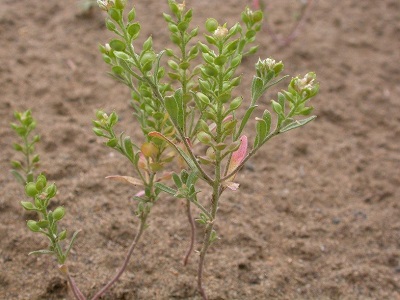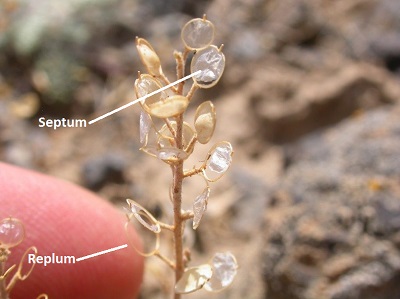Yellow and desert alyssum (Alyssum alyssoides and A. desertorum)

Matt Lavin, MSU.
History and status
Yellow and desert alyssum are native to northern Africa, eastern Europe, and western Asia. They were brought to North America for medicinal purposes because these species are said to cure hiccups, mental illness, and rabies. Both species were reported in Canada or the U.S. in the late 1800s to mid-1900s. Yellow alyssum is more widespread across Canada and the U.S. than desert alyssum. Each species has been reported in over 30 counties in Montana (data from EDDMapS and Consortium of PNW Herbaria). Yellow and desert alyssum were two of the most frequently submitted species to the Schutter Diagnostic Lab at MSU in 2017. Neither species is on the Montana noxious weed list.

Matt Lavin, MSU.
Habitat and spread
Both species grow at low to mid-elevations in disturbed soils of grasslands, steppe, streambanks, or roadsides, as well as rocky areas. Yellow alyssum can invade undisturbed areas and grow with established perennial bunchgrasses. Desert alyssum is potentially a weaker invader that requires the site to be disturbed before establishment. As annual plants, both alyssum species rely on seed production for reproduction. Since they are annual forbs, their populations can fluctuate widely from year-to-year.
Biology and identification
Both species are annual forbs belonging to the Mustard family (Brassicaceae). They are relatively short plants with yellow to white flowers, growing from 3-10 inches tall (photo above). Each plant is usually multi-stemmed and branches from the base. Similar to hoary alyssum (Berteroa incana), these species have star-shaped, or stellate, hairs covering the leaves and stems. The circular fruits on yellow alyssum are densely hairy, whereas desert alyssum has glabrous (hairless) fruits- this is the key feature to distinguishing the two species apart. Plants flower and fruit from April to July in North America. Later in the growing season after seeds have fallen, alyssum shows a persistent septum (the translucent wall between the two seed compartments) and replum (circular tissue anchoring the septum (photo right).
Impacts
Yellow and desert alyssum can be weedy on disturbed sites, particularly on overgrazed lands, and may displace desirable vegetation if not properly managed. Both species are relatively unpalatable to livestock. However, the seeds and foliage are eaten by western harvester ants, rabbits, pronghorn antelope, and sage-grouse.
Management options
Since these alyssum species do well in disturbed soils, it is important to take steps towards making your desired vegetation more competitive with weeds. Additionally, alyssum control should happen before seed production to limit persistence and spread. Plants may be mown just before flowering, or small patches of alyssum may be hand-pulled and disposed of in the trash. Research north of Yellowstone National Park showed that fall prescribed burns and revegetation resulted in reduced desert alyssum density the year after burning. Some herbicides recommended for control of alyssum are chlorsulfuron, glyphosate, imazapic, and metsulfuron. Herbicide applications in the fall may be most effective because yellow and desert alyssum often grow as “winter annuals”, meaning they emerge in the fall, overwinter as a seedling, and resume growth, produce seed, and die in the spring. In the fall, alyssum will be in a vulnerable seedling stage. Refer to the product label before using any herbicide.
